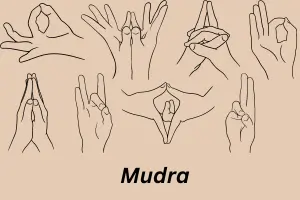Introduction
Mudra Yoga involves the use of hand gestures, also known as “mudras,” that help channel energy flow and enhance focus during yoga practice.
Each mudra is said to represent a particular aspect of life or spirituality and is designed to connect with the energy centers in the body.

These hand gestures are an integral part of yoga, meditation, and pranayama practices.
Mudras can be used to influence physical, emotional, and spiritual well-being by altering energy flows within the body.
Common mudras like Gyan Mudra, Chin Mudra, and Anjali Mudra are easy to practice and can provide numerous benefits.
Steps to Perform Mudra Yoga Pose
- Choose a Comfortable Seated Position:
Before practicing any mudra, find a comfortable seated position like Sukhasana (Easy Pose), Padmasana (Lotus Pose), or simply sitting cross-legged on the floor. Make sure your spine is straight, and your shoulders are relaxed. - Select a Mudra for Mudra Yoga
Based on your intention or goal for the practice, choose a mudra. Below are a few common mudras and how to perform them:- Gyan Mudra (Gesture of Knowledge): Touch the tip of your index finger to the tip of your thumb, forming a circle. Keep the other three fingers straight.
- Chin Mudra (Gesture of Consciousness): Similar to Gyan Mudra, except the palms face upward.
- Anjali Mudra (Gesture of Reverence): Bring your palms together at the center of your chest in a prayer-like position, keeping the fingers pointing upward.
- Prana Mudra (Gesture of Vital Energy): Touch the tips of your thumb, ring finger, and little finger together, keeping the other two fingers extended.
- Focus on Your Breath:
As you settle into the chosen mudra, close your eyes and focus on deep, steady breaths. Inhale and exhale slowly, allowing your breath to become a natural rhythm. Let your mind concentrate on the sensation of your breath and how it flows through your body. - Maintain the Mudra for a Set Duration:
Hold the mudra for 5-15 minutes or as long as you feel comfortable. If combined with meditation or pranayama, you can extend the practice to suit your needs. You can perform mudras during seated meditation or while practicing breathing exercises like Nadi Shodhana or Kapalabhati. - Release the Mudra Gently:
After completing the practice, gently release the mudra by opening your fingers and placing your hands on your knees or thighs. Take a few moments to observe how you feel physically and mentally after the mudra practice.
Benefits of Mudra Yoga Pose
- Promotes Mental Clarity and Focus:
Mudras help enhance concentration and mental clarity by directing energy flows in specific ways. They can calm the mind and improve focus, making them ideal for meditation and mindfulness practices. - Balances Energy:
Each mudra corresponds to a particular energy flow or element in the body, such as fire, water, air, earth, or ether. Practicing mudras can balance these energies, creating harmony between body and mind. - Enhances Breathing and Pranayama Practice:
Mudras often accompany pranayama techniques, helping practitioners deepen their breath and enhance the benefits of breathing exercises. This can improve lung capacity and oxygenation, supporting overall respiratory health. - Improves Emotional Stability:
Mudras can be used to calm the nervous system, reduce anxiety, and promote emotional balance. Regular practice can help manage stress, alleviate negative emotions, and promote a sense of peace and well-being. - Boosts Spiritual Growth:
Many mudras are associated with spiritual awakening and higher consciousness. By practicing mudras during meditation, practitioners can deepen their spiritual practice and connect with their inner selves. - Supports Healing and Physical Health:
Certain mudras, like Prana Mudra, are believed to stimulate the immune system and vitalize the body’s energy channels, promoting healing and rejuvenation. Mudras can also help alleviate specific ailments such as headaches, digestive issues, and fatigue. - Improves Hand and Finger Dexterity:
Performing mudras involves intricate movements of the fingers, which can improve flexibility and dexterity in the hands and fingers over time. This can be particularly beneficial for individuals with arthritis or joint stiffness. - Increases Mind-Body Awareness:
The mindful nature of mudra practice helps create a stronger connection between mind and body. By focusing on both the physical gestures and the breath, practitioners become more aware of their physical and mental states.
Precautions and Contraindications for Mudra Yoga Pose
- Hand or Finger Injuries:
Individuals with injuries or conditions that affect their hands or fingers, such as arthritis or carpal tunnel syndrome, should practice mudras with caution. Modifications may be necessary to avoid discomfort or strain. - Fatigue or Weakness:
If you experience fatigue or weakness in your hands or fingers during mudra practice, it’s important to take a break and rest. Overexerting the muscles can lead to strain or injury. - Consult with a Yoga Instructor:
If you’re new to yoga or mudras, it can be helpful to consult a certified yoga instructor to ensure proper technique. Some mudras may require specific alignment or focus that may not be immediately intuitive. - Practice with Mindfulness:
While mudras are generally safe, it’s important to approach the practice with mindfulness and awareness. Pay attention to how your body responds, and if any discomfort arises, release the mudra and adjust your practice. - Avoid Prolonged Practice without Breaks:
Holding a mudra for extended periods can sometimes lead to discomfort or tension in the hands or arms. It’s advisable to practice for short durations, especially if you’re new to the technique, and gradually increase the time as you become more comfortable. - Physical Conditions:
If you have a specific medical condition, such as high blood pressure or cardiovascular issues, consult a healthcare provider before engaging in extended mudra practices, especially those combined with pranayama or meditation.
Conclusion
- Mudra Yoga offers a simple yet profound way to enhance both physical and mental well-being through hand gestures.
- These powerful energy seals allow practitioners to tap into deeper levels of focus, mindfulness, and spiritual growth.
- By balancing the elements and energies within the body, Mudra Yoga can help improve emotional stability, mental clarity, and physical health.
- Incorporating Mudra Yoga into your daily yoga or meditation routine can amplify the benefits of your practice, fostering a deeper connection between mind, body, and spirit.
- Whether you are seeking mental peace, emotional balance, or physical healing, the gentle yet powerful practice of Mudra Yoga can guide you toward a state of harmony and inner calm.
- Like all aspects of Mudra yoga, the key to success lies in consistency, mindfulness, and an open heart.
- Take time to explore the variety of Mudra Yoga available, and let their energy-transforming power guide you on your yoga journey.
